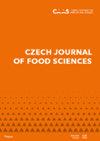番茄意面酱泡沫垫干燥的发泡特性、微观结构及数学模型
IF 1
4区 农林科学
Q4 FOOD SCIENCE & TECHNOLOGY
引用次数: 2
摘要
本研究以番茄为原料,采用泡沫垫干燥技术将意大利面酱干燥成粉末。研究了不同蛋清浓度(3%、6%和9%)和搅打时间(2min和5min)对意大利面酱泡沫特性的影响,包括泡沫密度、泡沫膨胀、泡沫粘度、水分活度、形态和干燥行为。泡沫酱汁在间歇式薄层干燥机中在恒定条件下(温度为60°C)干燥。采用六个薄层干燥模型来确定意大利面酱的干燥动力学。结果表明,蛋清浓度的增加和搅打时间的缩短产生了泡沫密度和粘度低、泡沫膨胀率高的泡沫酱汁。王和辛格模型是描述发泡酱汁干燥行为的最佳模型。根据Fick的第二定律模型,意大利面酱的有效水分扩散率范围为4.95×10–7至1004×10–7m2s–1。本文章由计算机程序翻译,如有差异,请以英文原文为准。
Foaming properties, microstructure, and mathematical model of foam mat drying of pasta sauce based on tomato
In the present study, the foam mat drying technique was used to dry pasta sauce based on tomato to become powder. The effect of different egg white concentrations (3, 6, and 9%) and whipping time (2 min and 5 min) on the foam properties of pasta sauce, including foam density, foam expansion, foam viscosity, water activity, morphological and drying behaviour, were investigated. The foamed sauce was dried in a batch-type thin-layer dryer at constant conditions (temperature of 60 °C). Six thin-layer drying models were employed to determine the drying kinetics of the pasta sauce. The results showed that an increase in the egg white concentration and a decrease in the whipping time produced a foamed sauce with low foam density and viscosity and high foam expansion. The Wang and Singh model was the best model to describe the drying behaviour of foamed sauce. According to Fick's second law model, the effective moisture diffusivity of the pasta sauce ranged from 4.95 × 10–7 to 10.04 × 10–7 m2 s–1.
求助全文
通过发布文献求助,成功后即可免费获取论文全文。
去求助
来源期刊

Czech Journal of Food Sciences
Food Science & Technology, Chemistry-食品科技
CiteScore
2.60
自引率
0.00%
发文量
48
审稿时长
7 months
期刊介绍:
Original research, critical review articles, and short communications dealing with food technology and processing (including food biochemistry, mikrobiology, analyse, engineering, nutrition and economy). Papers are published in English.
 求助内容:
求助内容: 应助结果提醒方式:
应助结果提醒方式:


